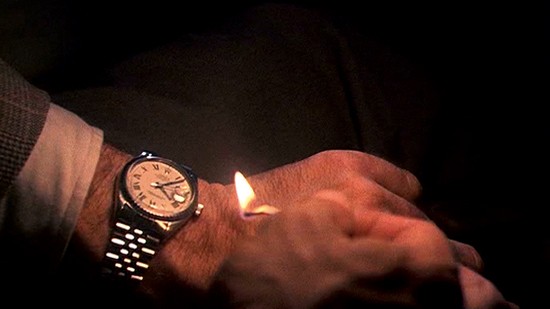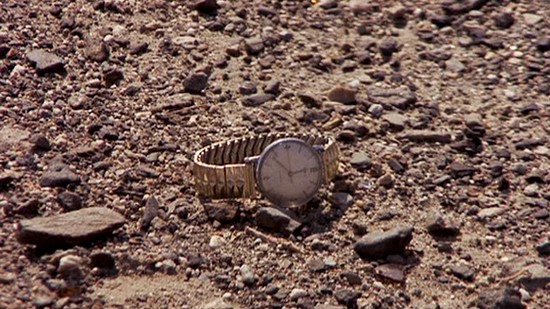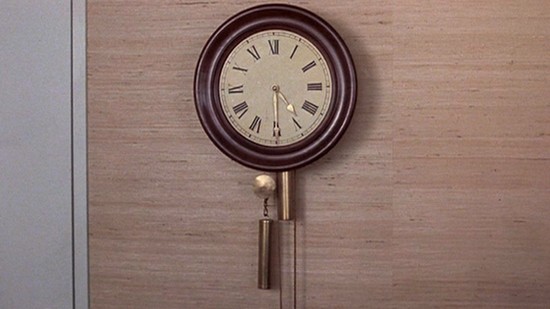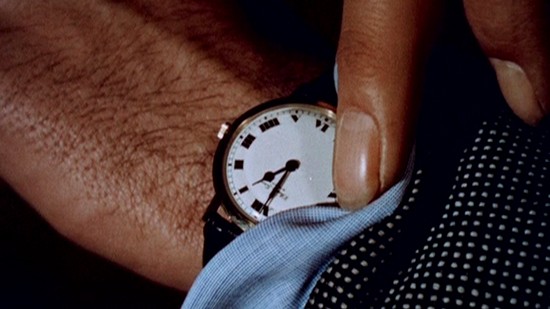By Andrew Maerkle
 All images: Still from The Clock (2010), single-channel video, 24 hours. © Christian Marclay, courtesy White Cube, London.
All images: Still from The Clock (2010), single-channel video, 24 hours. © Christian Marclay, courtesy White Cube, London.Produced over the course of two years, Christian Marclay’s The Clock (2010) combines clips from thousands of films into a 24-hour video collage that also functions as a working clock. Splicing together footage of clocks and watches for every minute of a 24-hour day, The Clock overlays filmic time with real time in a way that draws viewers into an endless narrative even as it triggers their recognition of temporal reality. This effect was achieved not only through intensive film editing to create a convincing, if false, continuity among the various actions depicted in the clips, but also through intensive sound editing to equalize the disparate soundtracks into a shared audio space.
The Clock also functions as a visual analysis of the use of time and narrative editing techniques in different film cultures, from worldwide Hollywood blockbusters to works of regional cinemas such as Bollywood and Asian independent film. A living archive, as such, the work entices viewers into revisiting their own personal experiences of film, collapsing the distinctions between the subjective time of memory and the linear time of the present.
Building upon Marclay’s previous works such as Telephones (1995) and Video Quartet (2002) that similarly string together clips from cinema into new contexts, The Clock stands out as a masterpiece for the artist, and one of the most memorable works of 2010. As part of our year-end special issue, ART iT met with Christian Marclay to discuss The Clock in greater detail.

ART iT: You spent several years researching and producing The Clock. Is there a difference between how you imagined the work as you were making it and how you think about it now that you have had time to review it?
CM: When I began the process of making the work I didn’t know whether it would even be possible to make, and it took an entire year before I sensed that it could be possible to find enough footage to represent every minute of a full day, and find ways to connect all these fragmentary events from different films into a continuous and almost seamless 24 hours.
It was a relief once I knew that I could eventually finish it, but even after the work went on exhibition I still spent another week redoing some of the sound elements, and correcting a few small problems with continuity. I finally came to terms with it and said, “OK, this is it; it’s finished.” I could easily work on it forever. And for the rest of my life I will notice clocks in films and wish I could have included them.
ART iT: What convinced you, after the first year, that it actually could be done?
CM: I had assistants helping me who would watch films and bring me clips periodically. My job was to edit, that’s what I did all day, so I never had time to watch any of the films myself, except perhaps when I was traveling on an airplane, and then if I saw something I would email my assistants to look for it. There was a whole period of research on the obvious films: anything that was even slightly related to time, such as films that have the word “time” or “clock” in the title, or films featuring events such as bank robberies that require the synchronizing of watches. I also told the assistants to look for scenes that are symbolically representative of time, images that we associate with time passing, with death, with memento mori, such as candles burning or cigarette smoking. In the end we ran out of ideas and they were watching practically every film ever made.
But the process was simple. I see The Clock as a structural film. I have 60 minutes to fill in an hour, and if a clock in a clip reads 5:06, I can only put the clip in that minute of that hour. It’s not a scientific clock, there’s a little fluctuation – never more than a minute or so – although if I had for example two clocks with the seconds visible I couldn’t reverse the order of the clips, so there’s a certain logic there. But a minute is a long amount of time in which many things can happen, so I could put a clip at the beginning or at the end or in the middle of the minute, and that position would be dictated by the action, and how the different narratives fit together. Certain actions can only precede others. In a way it was full of limitations.

ART iT: It’s amazing that you were able to actually track down enough footage for every hour of the day.
CM: There are these moments in films, just like in life, when nothing really happens – just before people wake up, or after they finish lunch, for example. I thought I would have to use more of that filler material with scenes of actions that we do every day at the same time, like people having breakfast, lunch, dinner. But in fact in cinema because it’s a big fantasy world, there are always extraordinary things happening. People don’t eat at lunchtime, they’re robbing a bank, or they’re running away from a bomb. Of course there is also the banality of everyday events, and many scenes of inaction, people waiting.
Another thing is that it forced me of course to look at these films very carefully and see how they are edited. One thing that I found really moving is to see the same actors coming back at different times of their lives, from being very young to being old – of course often not in that order. When you watch a movie you see it as a whole and even if you can recognize that the actor has aged, you quickly forget about it because you’re focusing on the character that they’re performing. But in The Clock to see someone show up three times at three different ages in the same hour is really strange. There are all these different layers of time in the work.
ART iT: Aside from the exhaustive film editing I understand that you also spent a lot of energy on sound editing, equalizing the audio of each and every clip you used. Do you think this is something that people are aware of when they see the work?
CM: People are probably less aware of that aspect of the work. Visually, it’s easy to notice when there is a juxtaposition from two different worlds – for example, moving from a Western into period piece set in the middle ages – but you wouldn’t necessarily think about the sound.
Through both my approach to the visual and the sound editing, I wanted to create a sense of false continuity. I wanted the sound to bring the imagery into the same space. It’s not necessarily about music. It’s about sound quality, a certain resonance, and that’s very hard to equalize when you’re cutting from a contemporary film with big surround sound and bass to a black-and-white film that has a tinny, optical soundtrack without any bass or treble. The sound is a very important part of The Clock and I spent a lot of time trying to achieve that fluidity.
.
ART iT: So you were purposefully avoiding a more drastic collage element in this case?
CM: I had a visitor when I was still doing rough edits using clips from all kinds of formats from CinemaScope to 4×3 to strange formats from old black-and-white films, all of which I was converting into 16×9. The visitor asked me why I was bothering to make everything unified. I just think viewers would very quickly tire of constant rough jump cuts.
You get caught up in The Clock because you’re watching what appears to be this endless film. You sort of know that it’s collaged together but part of you believes in it, so there’s this push-and-pull between multiple realities: the illusion of cinema and the obviousness of the collage and the reality of the real time. On top of that viewers bring their own experiences and that’s yet another level of fluidity, because they know what time it is and either they do or don’t have time to view the work, or they know how long they’ve been there. Their own time becomes part of the work.
What cinema usually does is to transport viewers to a different or abstract time where everything is compressed and someone’s whole life can pass by in two hours. We accept that even though we know it’s an illusion, but in The Clock, when everything’s happening in real time, it’s an illusion that also enters into reality.

ART iT: In your current exhibition in Seoul at Leeum, the Samsung Museum of Art, The Clock is being screened only during opening hours and not for its entire 24-hour cycle. Does that alter the nature of the work?
CM: Well, very few people will see the entire 24 hours in any case. It’s like an ambient thing: you don’t look at your wristwatch for a whole day, only when you need to check the time.
I do think that it must be frustrating for the audience, as it is for me. I want people to be able to see it whenever they like. But it’s difficult for an institution because it costs so much money to keep a space open 24 hours. I always thought the piece could be a public work displayed in an airport or train station where people have to wait and pass the time. But there are many restrictions in such a setting because people have to hear the announcements, and sound is so invasive. And then if you bring the work outside the sound might get lost or neighbors upset.
I think eventually people will be creative with it and find interesting spaces for making it accessible for 24 hours.
ART iT: Would you ever consider revising the work?
CM: I don’t think I want to go back there, unless I notice a major problem. The process was all consuming, and I was so focused on these little details, and then once I could see the bigger picture my perspective changed. I’m happy with the result so I don’t think I’m going to do anything else to it. It was mainly edited during these past 28 months, and the footage in the work is what I was exposed to at that time, and that’s what happened. It’s a document of a certain time and place at the beginning of the 21st century.
Christian Marclay‘s The Clock is currently on view in the solo exhibition “What You See is What You Hear” at Leeum, Samsung Museum of Art, Seoul, through February 13, 2011.
